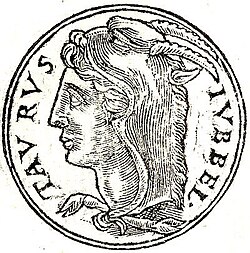Praenomina
The earliest Statilii bore common Oscan praenomina, such as Sthenius (or Statius) and Marius. In the late Republic, we find Lucius and Quintus , both among the most common praenomina throughout all periods of Roman history. The consular families from the first centuries of the Empire used Titus to the exclusion of all other regular praenomina, although two of the Statilii Tauri exchanged their original praenomina for the names Sisenna and Taurus. In the case of Taurus, the name was simply the cognomen of the family used as a praenomen, while Sisenna commemorated the descent of the family from the Cornelii Sisennae, a noble family of the Republic, through a female line.
Branches and cognomina
The most important branch of the Statilii bore the cognomen Taurus, referring to a bull, and belonging to a large class of surnames derived from the names of animals and everyday objects. [4] This family remained prominent from the end of the Republic to the reign of Claudius, and its name appears on coins of the era. [1]
Corvinus, borne as a surname by one of the consular Statilii, was inherited from his grandfather, Marcus Valerius Messalla Corvinus, consul in 31 BC, a descendant of the illustrious house of the Valerii Messallae, and of Marcus Valerius Corvus, who obtained his cognomen when, as a young soldier, he defeated a giant Gaul in single combat, with the apparently divine intervention of a raven, or corvus. [5] [6] [7]
A later family of the Statilii bore the cognomina Maximus and Severus, both common surnames throughout Roman history. Titus Statilius Maximus Severus Hadrianus, consul in AD 115, was the descendant of wealthy Syrian colonists. [8] Maximus, the superlative of Magnus, "great", could have described someone of great stature or high achievement, but was more often used to designate the eldest of several brothers. [9] Severus was used to describe someone whose manner was "stern" or "serious". [9]
This page is based on this
Wikipedia article Text is available under the
CC BY-SA 4.0 license; additional terms may apply.
Images, videos and audio are available under their respective licenses.


